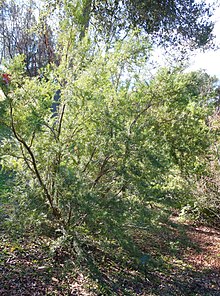Taxus sumatrana
| Taxus sumatrana | |
|---|---|

| |
| Scientific classification | |
| Kingdom: | Plantae |
| Clade: | Tracheophytes |
| Clade: | Gymnospermae |
| Division: | Pinophyta |
| Class: | Pinopsida |
| Order: | Cupressales |
| Family: | Taxaceae |
| Genus: | Taxus |
| Species: | T. sumatrana
|
| Binomial name | |
| Taxus sumatrana (Miquel) de Laub.
| |
Taxus sumatrana, or the Sumatran yew, is a large evergreen shrub and one of the eight species of yew. Its taxonomic namesake is indicative of the species being found in Indonesia (specifically, the island of Sumatra); however, T. sumatrana is also found in a number of South and Southeast Asian countries, including parts of Afghanistan, Bangladesh, Bhutan, China, India, Indochina, Nepal, Pakistan, the Philippines, Taiwan, and Tibet.[2]: 351 Given this broad geographical range, it is also known as the Taiwan yew, the Chinese yew, as well as the East Himalayan yew.[3] Plants of the World Online recognizes T. sumatrana as a synonym of Taxus wallichiana.[4]
T. sumatrana is typically found at elevations ranging from 400 to 3,100 m[5] and mainly in subtropical forests or on highland ridges. It is a government-protected species in Taroko National Park in Taiwan.
Appearance
[edit]Taxus sumatrana is a wide-trunked, bushy shrub that will eventually develop into a tree, attaining an average height of 14 m (approx. 45 feet). Its leaves are around 1.2–2.7 cm long and 2–2.5 mm wide (around 1”x1”), growing in two ranks along the branches and abruptly spiraling into an apex at the tip.[5] The foliage a pale yellow-green colour on the topside, with light green underneath. Its bark is grey-red which exfoliates in irregular, 1.5 mm (half an inch) thick flakes, which leave yellowish scars on the trunk almost immediately upon cutting.[5]
The Chinese yew has fleshy seeds that ripen into a red colour 6 mm long by 5 mm wide with flesh 4 mm thick.[2]: 350–351
Uses
[edit]The wood is suitable as timber, but it grows very slow to be financially viable.[2]: 351
On the Indian Subcontinent, the oil of T. sumatrana is traditionally used to mark a red tilaka on the foreheads of Brahmins. Chinese yews are also used for the crafting of clogs, whip handles, bed frames and bows (archery).
References
[edit]- ^ "Appendices | CITES". cites.org. Retrieved 2024-01-17.
- ^ a b c Markgraf, F. (1948). "Taxaceae". Flora Malesiana. 4 (1): 347–351 – via Naturalis Institutional Repository.
- ^ Richter, H.G., Gembruch, K., and Koch, G (2014). "CITESwoodID: descriptions, illustrations, identification and information retrieval". www.delta-intkey.com. Retrieved 20 August 2023.
{{cite web}}: CS1 maint: multiple names: authors list (link) - ^ "Taxus sumatrana (Miq.) de Laub". Plants of the World Online. Royal Botanic Gardens, Kew. Retrieved 29 August 2023.
- ^ a b c de Laubenfels, Miquel Taxus sumatrana, 1978, link Archived 2007-03-06 at the Wayback Machine retrieved on March 10, 2007
